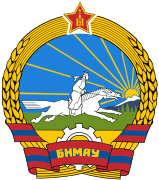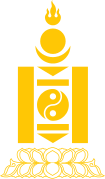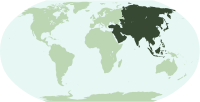| State emblem of Mongolia |
|---|
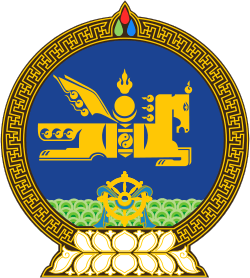 |
| Details |
|---|
| Armiger |
Mongolia |
|---|
| Adopted |
25 March 1992 |
|---|
| Escutcheon |
The outer rim features a tumen nasan, symbolizing eternity, surrounding a circular blue field, symbolizing the sky. On the centre of the field is a combination of the Soyombo symbol and the wind horse (treasured steed), symbolizing Mongolia's independence, sovereignty, and spirit. Sun, moon and fire symbols derived from Xiongnu. Above the field is a Cintamani (Чандмань), representing the Buddhist Three Jewels, which in Mongolian folklore grants wishes. Below the central emblem is a green mountain range, with the Wheel of Dharma (Хүрд) at the center. On the bottom of the mountain range and wheel is a khadag (Хадаг), a ceremonial scarf. |
|---|
The state emblem of Mongolia[1][2][3][4][5] (Mongolian: Монгол Улсын төрийн сүлд, Mongol Ulsīn törín süld) is used by the government of Mongolia as its symbol of state. It is officially used for example on documents such as Mongolian passports, and government and embassy placards.
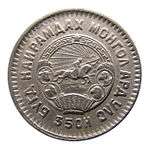
Mongolian coin 20
möngö of 1945
Description
The state emblem was adopted on March 25, 1992, following the fall of the Communist government. The details of it are laid out in Chapter 1, Article 12(2) of the Constitution of Mongolia.[1][5]
The outer rim features a tumen nasan, symbolizing eternity, surrounding a circular blue field, symbolizing the sky. On the centre of the field is a combination of the Soyombo symbol and the wind horse (treasured steed), symbolizing Mongolia's independence, sovereignty, and spirit. Sun, moon and fire symbols derived from the Xiongnu. Above the field is a Cintamani (Чандмань), representing the Buddhist Three Jewels, which in Mongolian folklore grants wishes. Below the central emblem is a green mountain range, with the Wheel of Dharma (Хүрд) at the center. On the bottom of the mountain range and wheel is a khadag (Хадаг), a ceremonial scarf.[1]
History
From 1960 to 1991, the Mongolian People's Republic used an emblem with a very similar shape, but with several differing elements. Instead of the Wind Horse, a horseman on a normal horse is shown. In the background, the sun rises above mountains. The Buddhist symbols are replaced by symbols of Socialism. A gearwheel stands for industrialization, sheaves around the perimeter stand for the farming class, and the top featured a red star with the socialist version of the Soyombo. Along the bottom, a blue-red ribbon is placed in front of the gearwheel, with the letters БНМАУ, the abbreviation for Бүгд Найрамдах Монгол Ард Улс, (Mongolian People's Republic).
Before 1961, the emblem did not bear most of the socialist symbols. The horseman carried a long lasso pole and the heads of four types of herd animals were shown on the sides. A red ribbon at the bottom bore the name of the country in the traditional Mongolian alphabet between 1940 and 1941 with the Cyrillic abbreviation after that.
From 1924 to 1939, the emblem was simply the Soyombo. In 1939, after the victory in the Battle of Khalkhin Gol, branches of Nelumbo were added.
| Soyombo of the People's Republic of Mongolia (December 2, 1924 - March 14, 1939) |
| Soyombo of the People's Republic of Mongolia (March 15, 1939 - April 5, 1940) |
| Emblem of the People's Republic of Mongolia (April 6, 1940 - October 31, 1941) |
| Emblem of the People's Republic of Mongolia (November 1, 1941 - March 5, 1960) |
| Emblem of the People's Republic of Mongolia (March 6, 1960-March 25, 1992) |
|
See also
References
- 1 2 3 "Chapter 1, Article 12(2)", Constitution of Mongolia, Ministry of Foreign Affairs and Trade, Mongolia, retrieved October 10, 2010
- ↑ "Chapter 1, Article 12(2)", Constitution of Mongolia, Embassy of Mongolia in the United States of America, retrieved October 21, 2010
- ↑ "Chapter 1, Article 12(2)", Constitution of Mongolia, United Nations High Commissioner for Refugees, retrieved October 21, 2010
- ↑ "Chapter 1, Article 12(2)", The Constitution of Mongolia, New York University School of Law, retrieved October 21, 2010
- 1 2 "Chapter 1, Article 12(2)", Mongolia - Constitution, Universität Bern, retrieved October 10, 2010


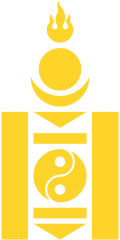

.png)
.png)
